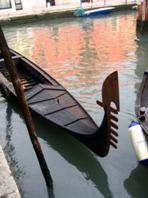Traditional Boats
The term traditional boat refers to boats with flat bottoms and shallow draft hulls. Due to the shallow water in the canals, the squerarioli were forced to craft the boats with a flat bottom to keep them from hitting the bottom of the canal. The shallow hull allowed the boats to be dragged to shore with minimal structural damage, made it easier for people to get in and out of the boat, and made it easier for standing passengers to balance. Such features were important for passengers crossing the Grand Canal in a type of gondola called a gondola da traghetto because it was customary for passengers to remain standing.

Types
Traditional Venetian boats can be sub-divided into the three main categories listed below:
Fishing and Hunting
Venice, like many coastal cities, is known for its seafood cuisine. Fishing in the lagoon requires boats that are capable of transporting large amounts of fish back to the island and the ability to maneuver within the lagoon. Three of the most-well known fishing and hunting boats are the topo, sanpierota, and the s'ciopon.
Large Cargo Transport
The city of Venice relies on boats for most large cargo transportation. Cargo boats are filled with anything from fresh fruit to construction supplies – everything the city needs is transported by boat. Transporting large, heavy cargo requires a vessel strong enough to do so, while maintaining maneuverability throughout the canals. Two of the most well-known large cargo transport boats are the caorlina and peata.
Human Transport
In early Venice, traditional boats were used as a means of both personal and public transportation. The most common and well-known human transport boats are the sandolo, mascareta, puparin, and gondola. Today motorized boats have replaced many of these human powered boats, and only the gondola remains as a tourist attraction.
Damage and Preservation
For information pertaining to the damage of traditional Venetian boats, please see the Damage to public art page.
For information pertaining to the preservation of traditional Venetian boats, please see the Restoration and preservation of public art page.
{{#compound_query:
|Traditional Boats;?Coordinates;?PV ID;icon=Red Marker.png
|Coordinates::+;?Coordinates;?PV ID;icon=Blue Marker.png
|limit=500
|height=500px
|format=map }}
See Also
| |||||
References
NULL
Bibliography
- Arzana | Per Lo Studio E La Conservazione Delle Imbarcazioni Veneziane. Web. 12 Oct. 2010. <http://www.arzana.org/>.
- The Boats of Venice. Venezia: Libreria Editrice, 1999. Print.
- Bigda, Bryan, Michelle Dubuke, Daniel LaTorella, and Jennifer Richards. Museo Arzanà: Preserving the Traditional Boats of Venice. Interactive Qualifying Project, Worcester Polytechnic Institute, 2007.
- Candlish, Sean, Craig Shevlin, and Sarah Stout. The Traditional Boats of Venice: Assessing a Maritime Heritage. Interactive Qualifying Project, Worcester Polytechnic Institute, 2004.
- Catalano, Brian, Kristen Gervais, and Ryan Sinapius. Preserving the Nautical Traditions and Maritime Heritage of Venice, Italy. Interactive Qualifying Project, Worcester Polytechnic Institute, 2005.